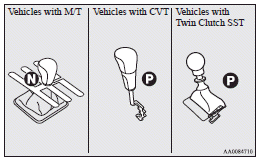Starting the engine (petrol-powered vehicles)
[For vehicles equipped with keyless operation system]
For information on operations for vehicles equipped with the keyless operation system, refer to “Keyless operation system: Starting” on pages 1-16, 1-20.
[Except for vehicles equipped with keyless operation system]
The starting procedure is as follows: 1. Insert the ignition key and fasten the
seat belt.
2. Make sure the parking brake is applied.
3. Depress and hold the brake pedal.
4. Fully depress the clutch pedal (M/T).
![]() Note
Note
► On vehicles with the Auto Stop & Go (AS&G) system, the starter will not operate unless the clutch pedal is fully depressed (Clutch interlock).
5. On vehicles equipped with M/T, place the gearshift lever in the “N” (Neutral) position.
On vehicles equipped with a CVT or Twin Clutch SST, make sure the selector lever (CVT) or gearshift lever (Twin Clutch SST) is in the “P” (PARK) position.

![]() Note
Note
► On vehicles equipped with a CVT, the starter will not operate unless the selector lever is in the “P” (PARK) or “N” (NEUTRAL) position.
On vehicles equipped with Twin Clutch SST, the starter will not operate unless the gearshift lever is in the “P” (PARK) position or the gearshift lever is in the “N” (NEUTRAL) position with the brake pedal depressed.
For safety reasons, start the engine in the “P” (PARK) position so that the wheels are locked.
6. After turning the ignition key to the “ON” position, make certain that all warning lamps are functioning properly before starting the engine.
7. Turn the ignition key to the “START” position without depressing the accelerator pedal, and release it when the engine starts.
![]() Note
Note
► Minor noises may be heard on engine startup.
These will disappear as the engine warms up.
Idling speed in high altitude area
At high altitude locations, the idling speed may be higher. This is done in order to stabilize the idling speed when the power steering system and other systems operate. It does not indicate a malfunction.
See also:
Keyless operation key take-out monitoring system
Type 1
Type 2
When the vehicle is parked with the ignition switch in any position other than
“LOCK” (PUSH OFF), if you close the door after opening any of the doors and taking
the keyles ...
Digital clock
Automatic mode and manual mode is available for digital clock adjustment.
Select the automatic mode or the manual mode by performing the following operations:
A- PWR switch
B- TUNE switch
1. Pre ...
Roof carrier precaution
Caution
► Make sure that the weight of the luggage does not exceed the allowable roof
load.
If the allowable roof load is exceeded, this may cause damage to the vehicle.
The roof load is t ...
